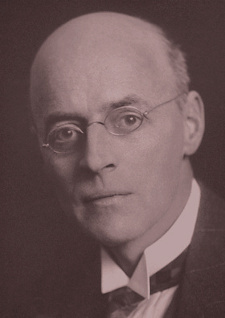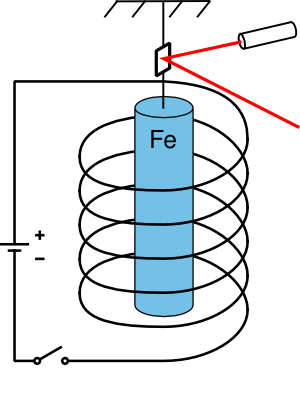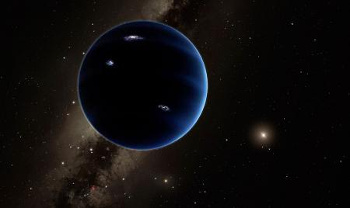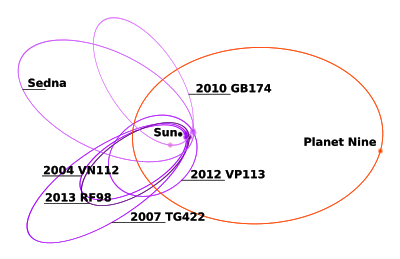Solar Tilt and Planet Nine
November 7, 2016
As all
scientists know,
nature is fond of throwing us
curveballs. Just when we think we have things figured out, the
data points head in an unexpected direction. A
baseball curveball drops downwards from a straight
trajectory, an effect caused by the
pitcher putting a forward
spin on the ball as it leaves his
hand.
There's an example of a confounding and stealthy spin in an early
physics experiment. While this experiment is sometimes called "Einstein's only experiment," more likely than not,
Albert Einstein didn't actually do the experiment. The experiment was probably performed by his
colleague,
Wander Johannes de Haas (1878-960), who improved on an experiment by
Owen Richardson (1879-1959).[1-2] De Haas was a
Dutch physicist known especially among
condensed matter physicists for the
De Haas–van Alphen effect.

Owen Richardson (1879-1959).
In 1901, Richardson discovered the exponential dependence of current on filament temperature in a vacuum diode. This is called Richardson's law in his honor.
(Wikimedia Commons image, modified for artistic effect.)
Although Richardson was the first to do the experiment, what was found is called the
Einstein–de Haas effect, and not the Richardson effect, since Einstein and de Haas gave the results a
theoretical framework. However, we need not feel too sorry for Richardson, since he went on to win the 1928
Nobel Prize in Physics for his work on
thermionic emission.
The Einstein–de Haas effect demonstrated the existence of
atoms using the simple apparatus shown in the figure. An
iron cylinder is suspended inside a
solenoid coil. When the
switch is engaged, the current through the solenoid produces a
magnetic field parallel to the axis of the cylinder. Despite the symmetry of the system, the iron cylinder unexpectedly twists.

An experimental demonstration of the Einstein-de Haas effect.
An iron cylinder hanging from a thin wire twists when a magnetic field, generated by a solenoid, is applied along its axis.
The small twist is measured by light deflected from a mirror.
(Wikimedia Commons image by Jasper Olbrich, modified.)
The twist is a consequence of an axial
angular momentum given to the iron cylinder. Since angular momentum must be
conserved in a
classical system, and the cylinder was initially at rest, there must be a contrary angular momentum developed inside the iron cylinder. This is the angular momentum of the invisible
electrons of the iron
atoms. What's even more interesting is the
Barnett effect, an effect
complementary to the Einstein-de Haas effect, in which a rotating iron cylinder becomes
magnetized.
There's another mysterious spin that occurs on a larger scale than this laboratory experiment. Our
Sun rotates, a fact known since the
telescope enabled
sunspot observations.
English astronomer and
polymath,
Thomas Harriot (1560-1621), who was the first to draw the
Moon as observed through a telescope on July 26, 1609, was also the first to telescopically observe sunspots in December, 1610. However, it was
Johannes Fabricius (1587-1616) who noticed their movement and an implied solar
rotation, now known to be about 25 days at its
equator.
The mystery is not the Sun's spin; rather, it's the
angle of its spin. The
orbits of our eight
Solar System planets are very nearly on a
plane known as the
invariable plane, which is very nearly the same as the plane of
Earth's orbit (the
ecliptic). However, the rotation axis of the Sun, termed its
obliquity, is
tilted 7.25° from this plane. Since all the Solar System bodies
coalesced from a
protoplanetary disk, the Sun's obliquity should be near zero.
This unusual solar obliquity has been an
astrophysics topic for at least 65 years.[3] In 2014,
Chadwick A. Trujillo, an astronomer at the
Gemini Observatory (Hilo, Hawaii), and
Scott S. Sheppard of the
Carnegie Institution for Science (Washington, DC), surmised the existence of a
Trans-Neptunian object now known as
Planet Nine.[4-5] It's now been
hypothesized that Planet Nine is the cause of the solar obliquity.[6-8] I wrote about Planet Nine in a
recent article (Planet Nine, June 27, 2016).

Dark and mysterious.
Artist's impression of Planet Nine.
(Caltech image by R. Hurt.)
Here are a few facts about Planet Nine.[9]
• Planet Nine is a hypothetical planet at the present. If its location were known, the Hubble Space Telescope would image it as just a few pixels.
• The mass of Planet Nine is estimated to be about ten times the mass of Earth. It should resemble a smaller version of Neptune.
• Planet Nine has an orbit about twenty times farther from the Sun than that of Neptune.
• The orbital period of Planet Nine is about 10,000-20,000 years.
• Planet Nine has a greater gravitational affect on the Solar System than any other known planet.

The orbit of Planet Nine and other Trans-Neptunian objects.
(Wikimedia Commons image by Karl432.)
Planet Nine's apparent affect on the Sun's obliquity arises from its large mass, and its imputed thirty
degree inclination to the invariable plane. Evidence for Planet Nine's influence on the Sun comes from the observation that it would also affect the orbits of quite a few objects, kicking their orbits far out of the invariant plane, and such objects have been observed.[4-6] One of these is
Sedna, a
minor planet three times farther from the Sun than Neptune. Sedna has an inclination of nearly 12°. Six
Kuiper Belt objects have orbits that appear to be in small
ratios with a massive planet like Planet Nine.[8]
Elizabeth Bailey,
Konstantin Batygin, and
Michael E. Brown, planetary astronomers at Caltech, announced their solution to the solar obliquity problem on October 18, 2016, at the
American Astronomical Society Division for Planetary Sciences 2016 annual meeting in
Pasadena, California.[8] A
paper on their
research has been accepted for publication in a future issue of the
The Astrophysical Journal.[7]
The
physical reason for Planet Nine's large affect on the Sun and outer planets is a consequence of angular momentum, as is the reason for the Einstein-de Haas effect that I presented above. In the case of a planet, the angular momentum is the
product of its mass and its distance from the Sun. Planet Nine has a large mass, and it's positioned quite far from the Sun.[7] Says Bailey, a graduate student who was lead author of the study,
"Because Planet Nine is so massive and has an orbit tilted compared to the other planets, the solar system has no choice but to slowly twist out of alignment."[7]
With this solution to the solar obliquity problem, there's a
confluence of evidence that points to the existence of Planet Nine.[7-8] Michael Brown is quoted in
The Guardian as saying, "...if there’s not a massive planet out there it has to be that there was one there yesterday and disappeared."[8] The planet's actual discovery should occur within the next few years.[7-8]
References:
- O. W. Richardson, "A mechanical effect accompanying magnetization," Physical Review (Series I), vol. 26, no. 3 (March 1, 1908), pp. 248-253.
- V. Ya. Frenkel, "On the history of the Einstein-de Haas effect," Soviet Physics Usp., vol. 22, no. 7 (July 1979), pp. 580-587 (PDF file).
- G. P. Kuiper, "On the Origin of the Solar System," Proceedings of the National Academy of Sciences, vol. 37, no. 1 (January, 1951), pp. 1-14.
- Kimm Fesenmaier, "Caltech Researchers Find Evidence of a Real Ninth Planet," California Institute of Technology Press Release, January 20, 2016.
- Konstantin Batygin and Michael E. Brown, "Evidence for a Distant Giant Planet in the Solar System," Astronomical Journal, vol. 151, no. 2 (January 20, 2016), Art. no. 22, http://dx.doi.org/10.3847/0004-6256/151/2/22.
- Elizabeth Bailey, Konstantin Batygin, and Michael E. Brown, "Solar Obliquity Induced by Planet Nine," arXiv, July 20, 2016.
- Robert Perkins, "Curious Tilt of the Sun Traced to Undiscovered Planet," California Institute of Technology Press Release, October 19, 2016.
- Alan Yuhas, "A possible ninth planet may be the reason for a tilt in our solar system," The Guardian (UK), October 19, 2016.
- Planet Nine Tilts the Sun! Q&A with Caltech Astronomers, YouTube Video, October 19, 2016.
Permanent Link to this article
Linked Keywords: Scientist; nature; curveball; data point; baseball; trajectory; pitcher; spin; hand; physics; experiment; Albert Einstein; colleague; Wander Johannes de Haas (1878-960); Owen Richardson (1879-1959); Dutch; physicist; condensed matter physicist; De Haas–van Alphen effect; exponential function; exponential dependence; current; hot cathode; filament; temperature; vacuum diode; Richardson's law; Wikimedia Commons; Einstein–de Haas effect; theory; theoretical; Nobel Prize in Physics; thermionic emission; atom; iron; cylinder; solenoid coil; electric switch; magnetic field; parallel; experiment; experimental; Einstein-de Haas effect; iron; cylinder; wire; axis; light; mirror; Wikimedia Commons; angular momentum; conservation of angular momentum; classical physics; electron; atom; Barnett effect; complementary; magnetization; magnetized; Sun; solar rotation; telescope; sunspot; English; astronomer; polymath; Thomas Harriot (1560-1621); Moon; Johannes Fabricius (1587-1616); equator; angle; orbit; Solar System; planet; plane; invariable plane; Earth's orbit; ecliptic; axial tilt; obliquity; tilted; coalescence; coalesce; protoplanetary disk; astrophysics; Chadwick A. Trujillo; Gemini Observatory (Hilo, Hawaii); Scott S. Sheppard; Carnegie Institution for Science (Washington, DC); Trans-Neptunian object; planet Nine; hypothesis; hypothesize; artist's impression; R. Hurt; Hubble Space Telescope; digital imaging; image; pixel; mass; mass of Earth; Neptune; orbital period; year; gravitation; gravitational; Trans-Neptunian object; Karl432; degree; orbital inclination; Sedna; minor planet; Kuiper Belt object; ratio; Elizabeth Bailey; Konstantin Batygin; Michael E. Brown; American Astronomical Society Division for Planetary Sciences 2016 annual meeting; Pasadena, California; scientific literature; paper; research; The Astrophysical Journal; physics; physical; product; confluence; The Guardian.